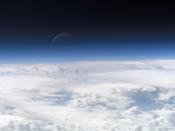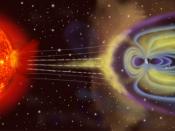Sunspots are dark areas on the solar surface that contain transient and concentrated magnetic fields. They are the most prominent visible features on the photosphere Sun; a moderate-sized sunspot is about as large as Earth. Sunspots form and dissipate over periods of days or weeks. They occur when strong magnetic fields emerge through the solar surface and allow the area to cool slightly, from a background value of 6000 degrees C down to about 4200 degrees C; this area appears as a dark spot in contrast with the Sun. The darkest area at the centre of a sunspot is called the umbra; it is here that the magnetic field strengths are the highest. The less dark, striated area around the umbra is called the penumbra. Sunspots rotate with the solar surface, taking about 27 days to make a complete rotation as seen from Earth. Sunspots near the Sun's equator rotate at a faster rate than those near the solar poles.
Groups of sunspots, especially those with complex magnetic field configurations, are often the sites of flares.
Sunspot activity has been observed since the time of Galileo in 1610, with detailed records kept for over 200 years by specialist solar observatories. The temperature within sunspots is about 4,600 K, and there appears to be a sunspot cycle that peaks every 11.1 years.
When sunspots occur, they can interfere with the terrestrial plasma environment, causing magnetic sub-storms, auroral activity, power outages and influencing everything from telecommunications to the electrical power grid. As they near Earth, the magnetic storm compresses the bow wave of the magnetosphere and the auroras rage as particles penetrate the field's defences at their lowest points near the poles and spiral around the Earth's lines of force back and forth between the magnetic poles. The ring current running around...


